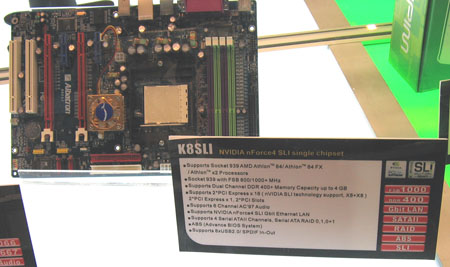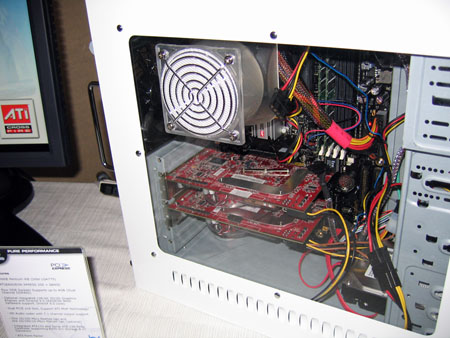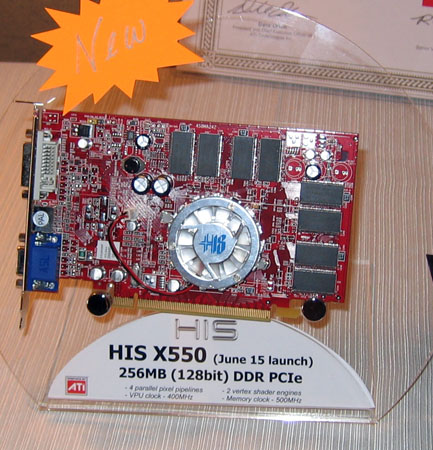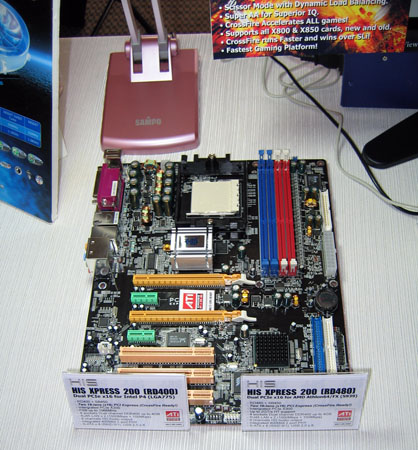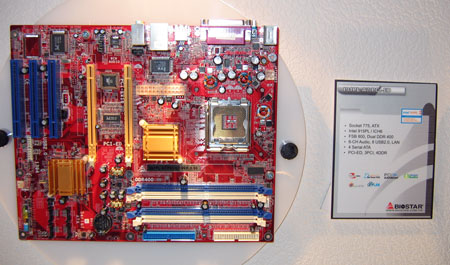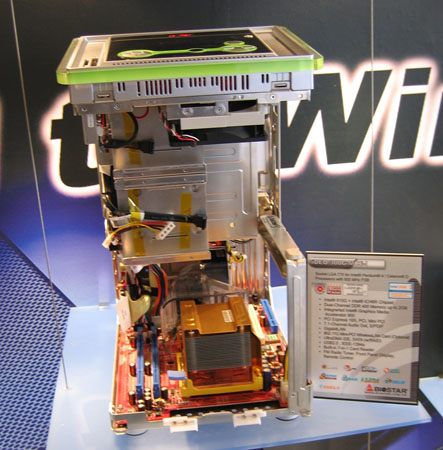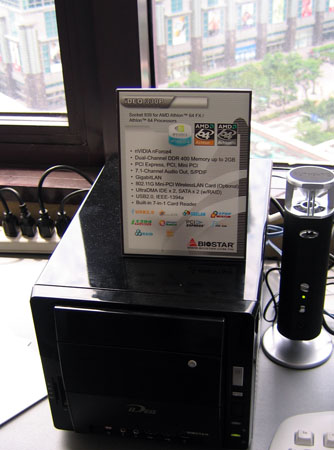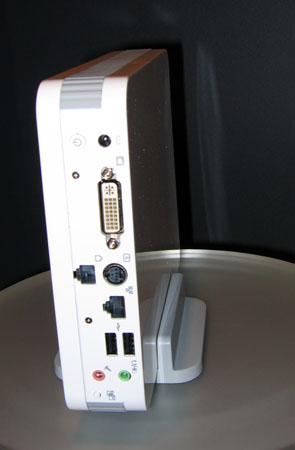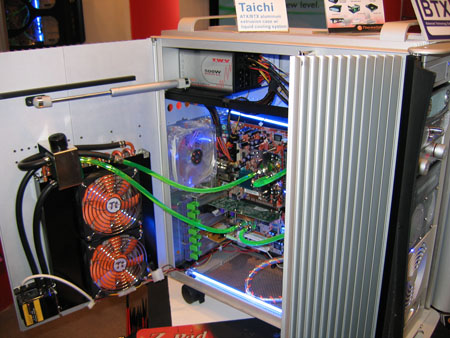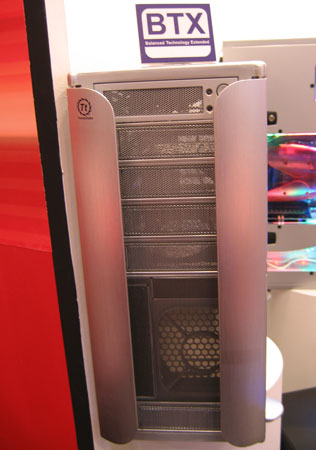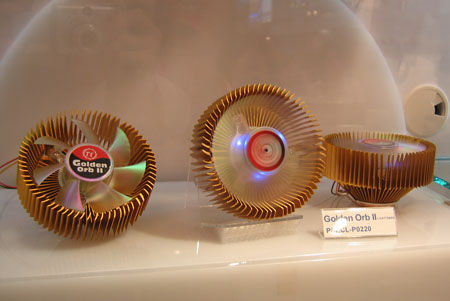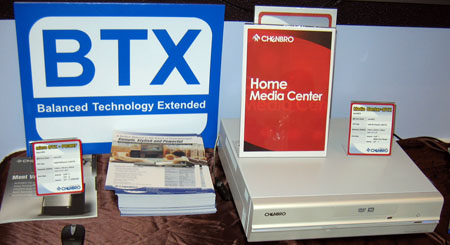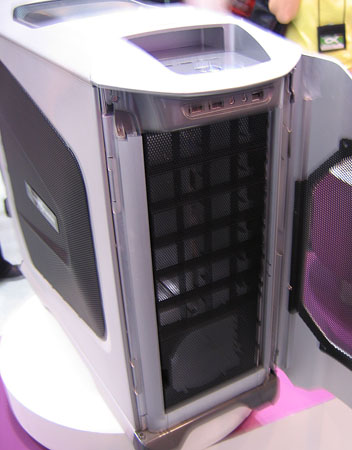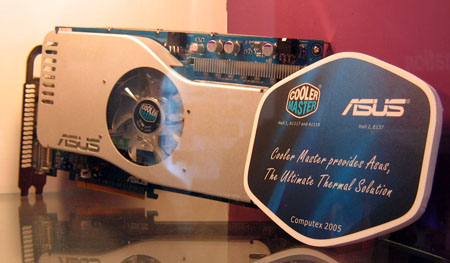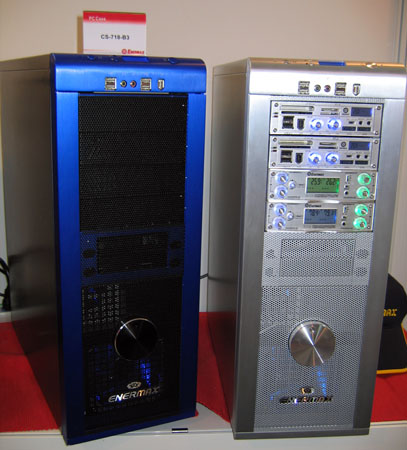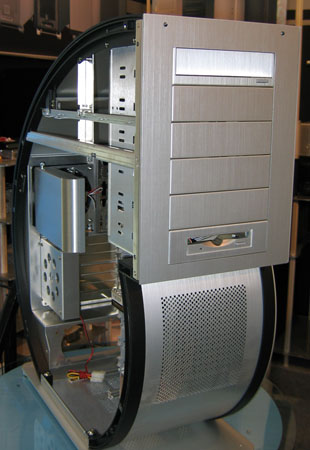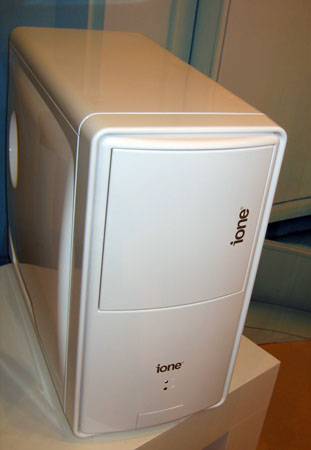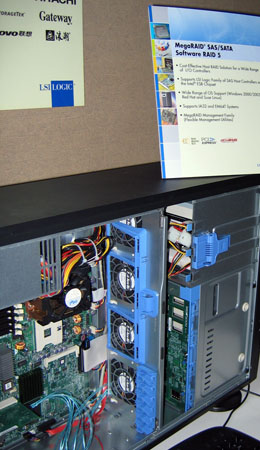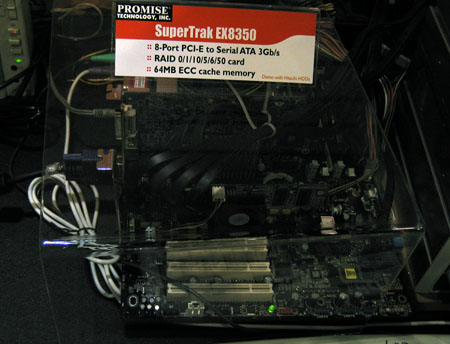
Original Link: https://www.anandtech.com/show/1701
Computex 2005 - Day 3 Tidbits
by Kristopher Kubicki on June 1, 2005 11:06 PM EST- Posted in
- Trade Shows
Introduction
Day 3 of Computex came and went; the relentless near-100% humidity, minor earthquakes, smoke-filled rooms and continuous wailing of international businessmen intimidates all but the most seasoned show goers. Even though we have been in Taipei for almost a week, new technology is still everywhere and never ceases to amaze us. The crowds are a little smalller than other years, but fortunately for us, it seems that the majority of the attendees are actual vendors, buyers and manufacturers (unlike previous years when a strong majority of local inquisitors composed the bulk of the audience).Albatron
Albatron had several new items on display, although most of them are not terribly new. Albatron product managers emphasized their new BIOS solutions for both graphics cards and motherboards.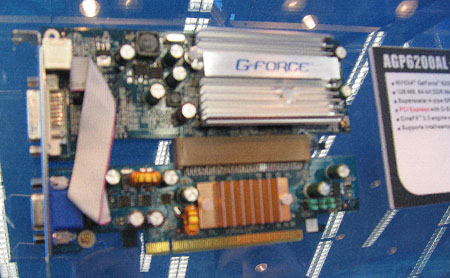
Albatron also had their K8SLI motherboard on display – the narrowest nForce4 SLI motherboard that we have seen outside of an SFF.
Sapphire
Sapphire was the talk of E3 with their “ Nano-Cooler” liquid metal demonstration. Aside from the fact that NanoCoolers require no moving parts to work, the relatively small packaging just continues to sweeten the deal. In the image below, the X850XT uses two fans to cool the heat exchanger, but the final product will only need one.The heatpipes – filled with the liquid metal alloy – were warm to the touch, but not searing hot like traditional heatpipes. The final product will also use a reduced electronics package, since the bulk of the electronics featured in this shot are actually for the prototype fans.
RD400 ( Xpress 200 Crossfire for Intel) was also on display. Most of the ATI partners had some demonstrations of RD480, but very few had RD400.
HIS
The other graphics companies might be working on some neat projects, but ATI powerhouse HIS has a few tricks up their sleeve too. Aside from the working RD480 ( Xpress 200 Crossfire) demonstrations, HIS was very proud to announce their next generation ICEQ coolers. The redesigned fan cooler was able to drop heat sink temperatures from 75 degrees Celsius to 58 degrees Celsius in the working demo at the show; but HIS product managers emphasized that this was a best case and that temperatures during 3D rendering usually dropped about 11 degrees on average.Below, you can see that the new ICEQ system pulls air in from the case and draws it over the entire heat sink.
HIS also had a prototype X550 graphics card on display – something that we touched on a little yesterday. The X550 card (core RV370XT) is really nothing more than an overclocked X300 graphics card. HIS claims that it is to fall in line with the Radeon 9550 AGP performance, but don’t expect to see an actual release of a new video card until R520.
Below is a shot of HIS’s own lineup of RD480 and RD400 motherboards.
Biostar
Everyone and their brother had 945P motherboards on display this week, and some had dual 16 lane PCI-E interfaces on their motherboards. The dual x16 is actually slightly misleading, since the second adaptor is really just an x4 in an x16 slot. Since saturation of the PCI-E bus is something that graphic manufacturers still dream about, we aren't giving anyone a hard time about only putting 4 or 8 lanes on an x16 interface (yet).But Biostar didn't just have a 945P motherboard with two graphics adaptors. They also had a 915P board with two as well! Practical? Perhaps not - but unique? Absolutely. As cheap as other 915P motherboard prices have fallen in the last few months, a new, inexpensive 915P motherboard with extra room for graphics might find some niche somewhere. In the remote opportunity that NVIDIA opens its SLI driver to steal ATI's Crossfire thunder, some of these 915P and 945P dual graphics motherboards are actually capable of rudimentary "SLI" performance.
Biostar's real focus this year was on the small form factor (SFF). An entire room in the Biostar suite was dedicated to SFFs, with plenty of 945G and nForce4 designs. However, we didn't see an nForce4 SLI setup like we did at Shuttle's suite yesterday.
Biostar did have an SFF based on C51G - a.k.a. nForce4 IGP. Some of the finer points about the chipset are revealed in the note card next to the system, including integrated 6200TC graphics and 7.1 channel audio (not SoundStorm 2).
Intel
Speaking of SFF, Intel partnered up with FIC to produce one of the most unoriginal, but still interesting, looking products to enter the small form factor world. The Mac-Mini knockoffs are based on Pentium M processors and only require a single internal fan.The DC inverter is not housed inside the system, but all other components are. The SFF units are primarily legacy free, but have a traditional RJ-11 input for what we can only guess is caller ID. The booth claims that the Mini-knockoffs are for the digital home, but the lack of HDMI indicates otherwise for us. Since these are proof-of-concept machines, we can't criticize them too much - but don't expect to see something like this anytime soon at Fry's.
Cases
Last year at Computex, BTX was the talk of the town. A year later, BTX didn’t have much to offer. As Anand stated yesterday, motherboard manufacturers are downplaying the importance of BTX, claiming that case manufacturers aren’t ready for the new standard. Meanwhile, case manufacturers keep telling us that there aren’t any retail BTX motherboards, so there is no point in building new BTX cases. Whether or not BTX is really a step forward is still debateable to some, but everyone agrees that it’s going to take an outstanding step from AMD or Intel to get these guys to start working together.ThermalTake
Now that ThermalTake has a few years of experience under their belt, their case designs are really starting to mature a bit. No more are they gaudy cases based on Chenming reference designs; ThermalTake’s new stuff is all completely designed in house nowadays – our ThermalTake representative was excited to announce to us that there are over 50 R&D employees in Taiwan alone with the company.The Taichi is ThermalTake’s new flagship design at the show. What makes this a cool case is the fact that it was designed from the ground up to be a watercooling case – the reservoir, piping and waterblock are all integrated into the design. The BTX sign on top of the case is slightly misleading, since this is not a BTX case.
For those who remember the Armor series, a Mini-Armor is on its way. More the size of a mid-ATX case, this is actually a BTX compliant chassis. The Mini-Armor took the prize as one of the better looking BTX cases that we saw at the show.
New revisions on the Eclipse and Circle case are coming as well. Eclipse was always a personal favorite of ours – but the Eclipse DV aims to really impress. What looks like just a CD holder is actually a CD/DVD player. Retail shipments are a little ways off, but you can be assured that we will take a look at this interesting design once it becomes available.
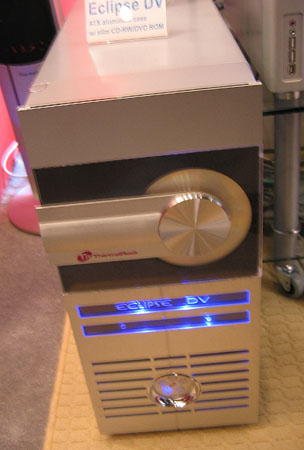
Chenbro
Unfortunately, Chenbro had very few new designs available, but they did have an HTPC BTX case in brushed aluminum.CoolerMaster
There wasn’t much in way of CoolerMaster’s new cases either. The focus of the CoolerMaster booth was a next generation Stacker design, but it’s a bit larger than their previous Stacker.CoolerMaster was also proud to show off ASUS dual 6800 Ultra video card based on CoolerMaster’s cooling design.
Enermax
Apparently, we missed the memo, which said that every case company needs at least one case based on aluminum mesh. Here are Enermax’s new CS-718 cases.Lian Li
The pioneer of aluminum chassis didn’t have many new products either. The focus of their display was a brushed aluminum BTX and ATX compatible concept case, but it looks a little too large for us to find practical, personally.Lian Li has spent a lot of resources getting into desk production as well. These super-desks cost about $2000, but are completely sheathed in scratch-resistant brushed aluminum. Below, a Lian Li product manager attempts to scratch the table with a coin.


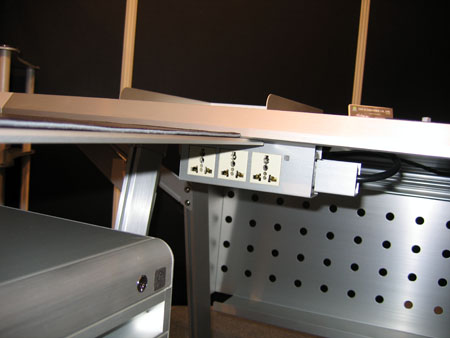
MGE
Just about a year ago, we saw the first “Dragon” prototypes at Computex, but a year came and went and no retail cases ever came to the US. Apparently, there were some structural problems with the case and a revision had to be completed. The Dragon 2 aims to correct these problems, although some of the “wow” factor has definitely diminished.Another one of MGE’s new designs was the Ninja 2.
In the “prototype” section of MGE’s booth, we had a chance to look at MGE’s Ione line. Ione will be the second case lineup for MGE – a more reserved lineup primarily aimed at HTPCs.
Storage
Everyone and everybody couldn’t stop talking about Raid 6 at the show this year. Raid 6, for those not familiar, is a striping technology similar to Raid 5, but considerably more resource and CPU intensive. On the upside, a Raid 6 array can lose as many as two disks before failure, and even the loss of one or two disks will force the array to begin repairing itself in the background. The only downside to this technology, because it is so CPU intensive, is that it only comes in software form. The hardware is still needed to support Raid 6, but a software driver is what actually enables the technology. The other downside is that many disks are needed for Raid 6 to really become viable. Don’t expect to run this on your desktop to increase World of Warcraft performance – this is pretty much server level technology. There were also some new SAS and Infiniband controllers on the show floor at HighPoint, and those are technologies that we will definitely keep an eye on.LSI
Besides their Raid 6 demonstrations, LSI also had a considerable amount of their suite dedicated to MegaRAID, their SAS and SATA software RAID 5 solution. While BSD operating systems have enjoyed Raid 5 software RAID via the OS for years, Linux and Windows have not been as fortunate. MegaRAID will support 32-bit and 64-bit operating systems.Promise
Below, you can see a shot of Promise’s Raid 8-port SATA controller with Raid 6 support and 64MB of ECC cache on board.NetCell
Running from meeting to meeting, we met a very interesting employee from a company called NetCell. While we don’t have exact details at the moment, the NetCell employee mentioned that they were developing a transparent technology that built Raid 3 arrays. Raid 3 works similarly in the manner of Raid 5, but an entire hard disk is devoted to parity instead. Thus, one could lose an entire drive (or the parity drive) and still function fine. The advantage is performance – there are fewer duplicate writes – but a three-disk array only has the capacity of two disks. What NetCell aims to do is make this technology completely transparent to the user. Plugging three drives into the NetCell controller will set up the raid stripe automatically and further configuration is handled by the chip. Since there is no CPU overhead (unlike Raid 6), NetCell might have a pretty interesting technology in the near future – particularly for gamers and enthusiasts.Displays? (Or lack thereof)
If there was a letdown this year, it was in the displays. While all of the big Taiwanese manufacturers were here, usually there are entire halls filled with nothing but displays with impressive specifications. Unfortunately, hard times have fallen on LCD panel manufacturers outside of the big three ( LG.Philips, Samsung/Sony and Sharp) and the smaller companies are starting to really hurt.AUO, famous for their low response time 6-bit LCD panels in all but the largest LCD TVs, posted losses for the second quarter in a row. The company vows to ride out the oversupply of panels on the market, but if the number four panel manufacturer is having difficulty turning a profit, the little guys don’t have a chance.
One of those little guys, Chi Mei Optoelectronics, barely had a presence at the show this year (compared to their booth last year that took up several spots). Ultimately, a consolidation of the market is probably better for end users as the LCD spot market becomes a thing of the past – hopefully, removing the opportunity for Tier 2 manufacturers to start flooding the market with low quality displays.
BenQ, Sampo and AG Neovo had booths at the show, but you can tell the attitude was more subdued than it has been in the past. No high resolution 19” displays or new single digit response time panels graced our presence this time around. CES is the better show to view new display technology, since it isn’t primarily limited to just Taiwanese manufacturers like Computex, but hopefully, we don’t have to wait until January to see innovation in a rapidly consolidating industry.
More coverage tomorrow!

